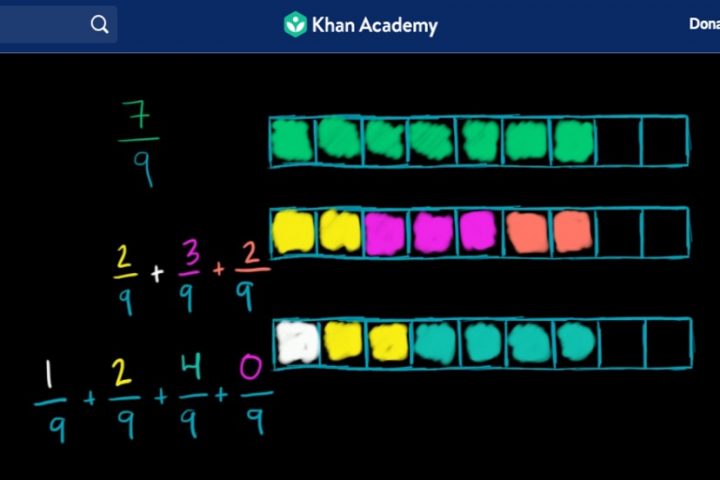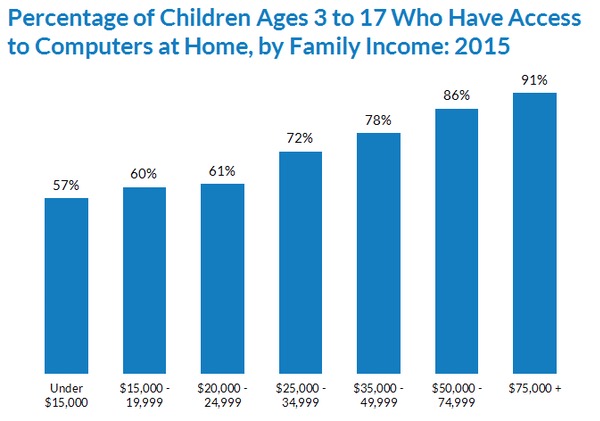My granddaughter Amelie, age 10, is sitting at the dining room table this morning, learning how to decompose fractions.
Like so many school children around the world, she’s spending time in front of a computer screen instead of sitting in a classroom full of fellow students. Her public school has been closed by a state government order — one of the many blunt tools we’re using to slow the spread of the novel coronavirus — and instruction (and social interaction) is occurring online. Amelie is just now logged into a popular math-instruction website known as Khan Academy, which offers free arithmetic and mathematics lessons to anyone with access to a computer and an internet connection.

According to the PEW Research Center, about 80 percent of American households own a computer, and about the same percentage have an internet connection. But internet access depends, to some degree, upon your family income. According to ChildTrends.org, children in households with lower incomes are less likely to have home computer access. Only about half of the children living in households earning under $15,000 per year have access to a computer, compared with 91 percent of those in households earning $75,000 or more annually.

I must have learned how to decompose fractions at some point in my elementary school career, back in the 1960s — because, as I watch over Amelie’s shoulder, the Khan Academy lesson looks comfortably familiar. But I don’t recall any of my elementary school teachers referring to this process as “decomposing.”
Lessons in decomposing fractions can eventually lead up to the ability to convert a fraction like…

…into a possibly more useful rendering, like…

But I’m almost 68 years old, and I have never, in my life, run across an authentic opportunity to decompose a fraction like ‘twenty-two sevenths’. I ask you honestly, how many people have ever found a practical use for a number like ‘three-and-one-seventh’? I’d like to hear from any Daily Post readers who may have had that experience.
I have, meanwhile, decomposed simple fractions on numerous occasions, when doubling a recipe. For instance, I’ve learned that…

I often complain about relatively useless information and skills drilled into school children, while some really important stuff is totally ignored. Mathematics exists in the real world, and its crucial to understand not only how you can manipulate numbers, but how other people might try and manipulate you using numbers.
Children need to learn that some numbers are meaningless. Or downright dangerous.
For example, we have a fascinating and complex mathematical experience taking place, at this very moment, all over the world. How many people have tested positive for the novel coronavirus? Who’s getting tested, and who isn’t? How many of those who tested positive have become seriously ill? Most of them… or only a few? What are the chances that the numbers we’re seeing are accurate? What factors are determining the accuracy of the number?
What factors are determining the size of these numbers?
These are serious numerical questions that it might be useful to explore in a math class.
Some COVID-19 numbers can be rendered as fractions, but most often we see them shared as percentages — that is to say, fractions that use ‘100’ in the denominator. I wonder how many fourth graders understand percentages — during a global situation where percentages are getting updated by the minute?
I wonder how many fourth graders understand the role of politics in defining those numbers?
On January 20, 2020, a 35-year-old man in Washington state, recently returned from visiting family in Wuhan in China, became the first person in the US to be diagnosed with the virus. On the very same day, 5,000 miles away, South Korea reported its first confirmed case of COVID-19 .
Within a week of its first confirmed case, South Korea’s disease control agency had summoned 20 private companies to the medical equivalent of a war-planning summit and told them to develop a test for the virus at lightning speed. A week later, the first diagnostic test was approved and became a crucial tool for identifying infected individuals who could then be quarantined. Some 357,896 tests later, South Korea had more or less won the coronavirus war. On Friday, March 27, only 91 new cases were reported — in a country of more than 50 million.
Things went very differently across the Pacific, in the United States of America. Two days after that initial diagnosis in Washington state, President Donald Trump went on television and informed an anxious nation: “We have it totally under control. It’s one person coming from China. It’s going to be just fine.”
A week later, the Wall Street Journal published an op-ed by two top health policy officials, Luciana Borio and Scott Gottlieb — formerly employed within the Trump administration — who laid out a menu of what needed to be done immediately to avert a massive health disaster. At the top of their list: work with private industry to develop an easy-to-use, rapid diagnostic test. In other words, we must immediately start doing what South Korea was doing.
It was not until February 29 — more than a month after the WSJ op-ed, and almost six weeks after the first case of coronavirus was confirmed in the US — that the Trump administration put Borio and Gottleib’s advice into practice, and finally allowed laboratories and hospitals to conduct their own COVID-19 tests.
Thus, we have two fractions that our school children might wish to decompose. It’s now been 10 weeks since the first confirmed case in South Korea, and in the US.
On March 30, South Korea reported a total of 158 fatalities from COVID-19, since January 20. We could render that as a fraction:

A clever fourth grader might be able to decompose that fraction, and find a value of approximately 16 deaths per week. And the rate appears to be falling.
Then we have the US fraction:

Decomposed, that appears to be about 294 deaths per week. And the rate appears to be climbing.
We might also note, in passing, that South Korean high school students consistently outperform their peers in the US, on international math tests.

